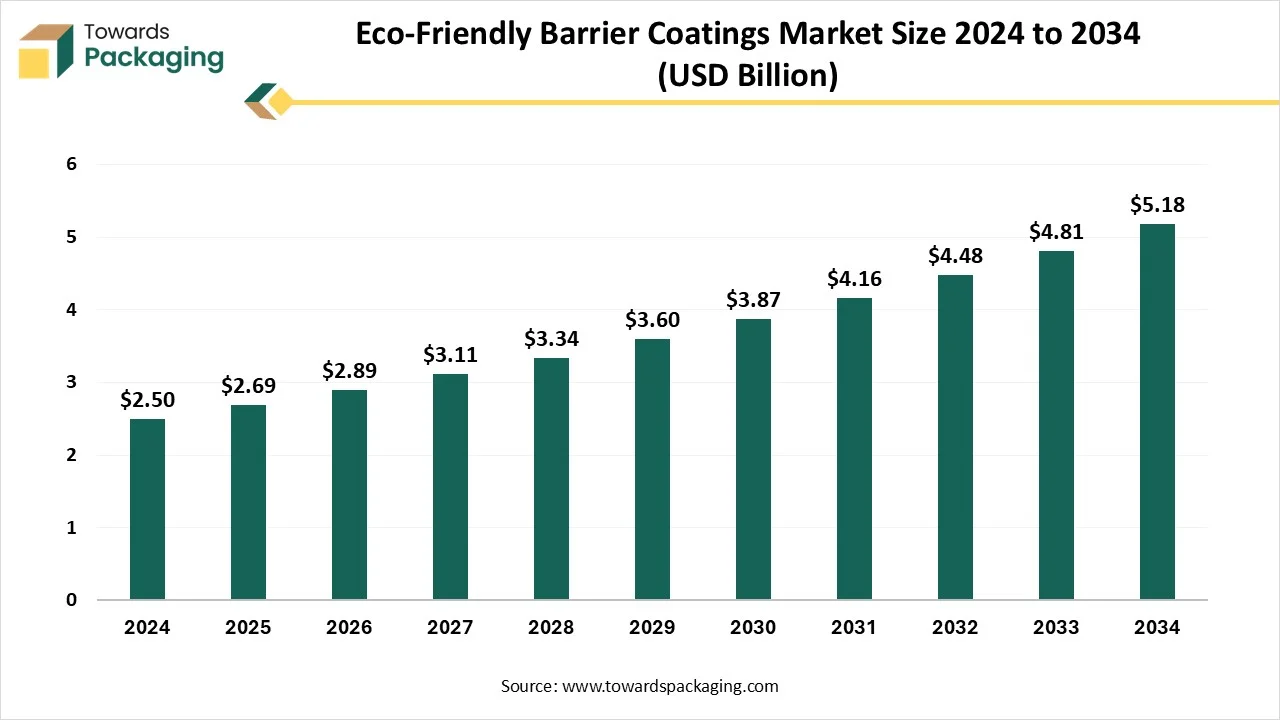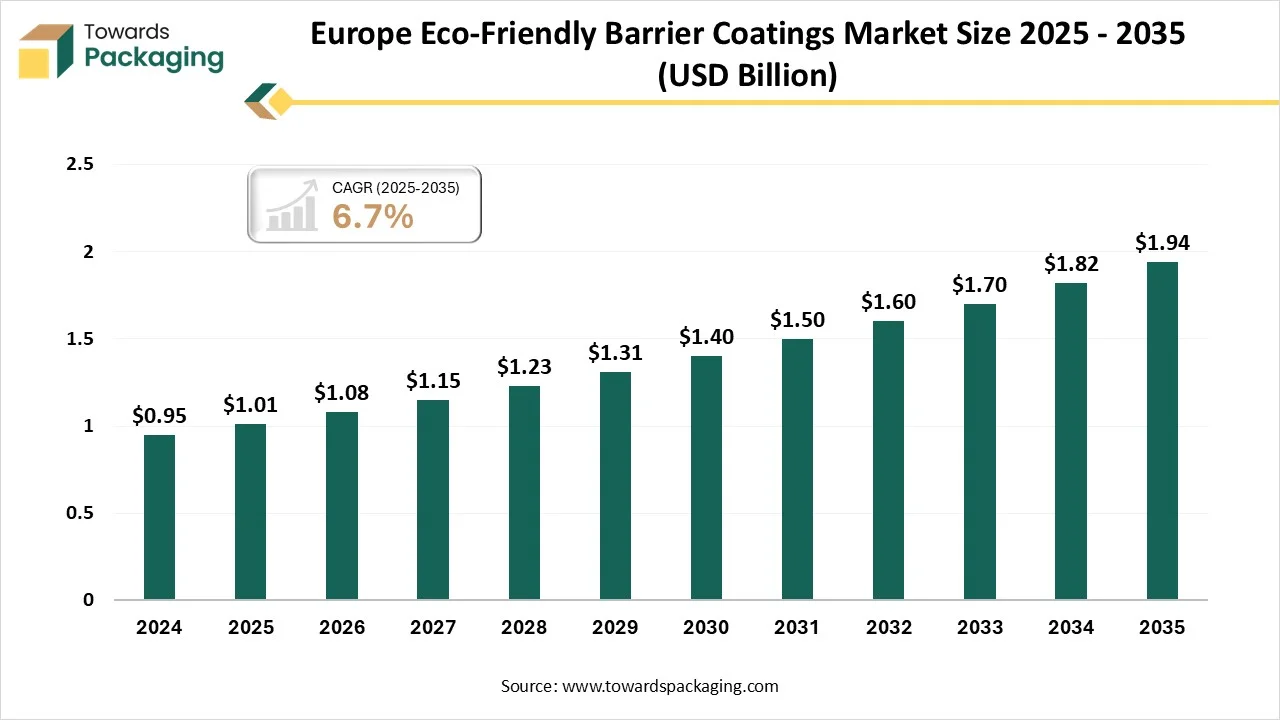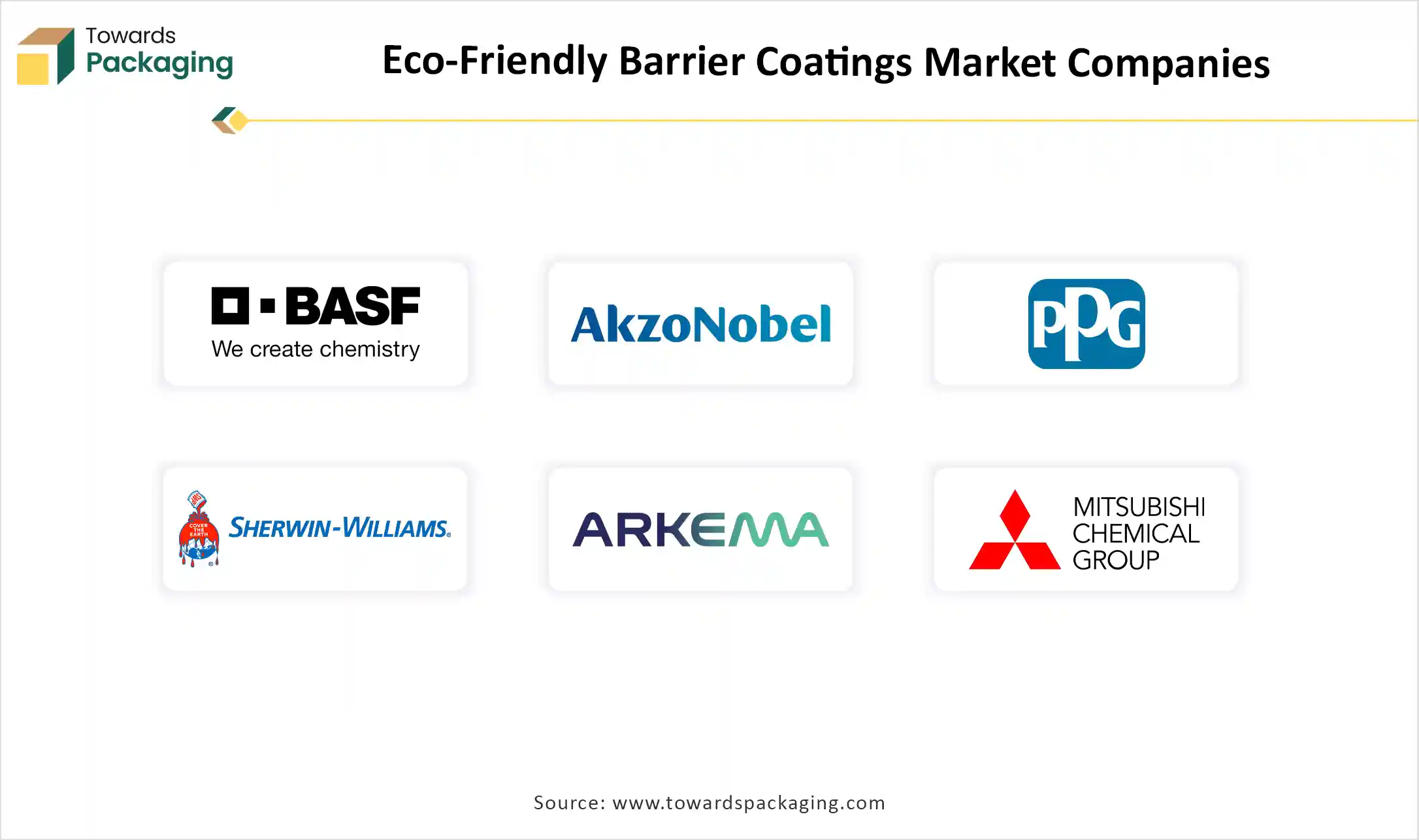November 2025
The eco-friendly barrier coatings market is projected to reach USD 5.57 billion by 2035, expanding from USD 2.89
billion in 2026, at an annual growth rate of 7.55% during the forecast period from 2026 to 2035. The rapid development of the packaging sector to meet the demand for several industries such as personal care, cosmetics, food & beverages, and many others has influenced innovation. There is a huge demand for recyclable, sustainable, and degradable packaging resolution, this encouraged the development in the market. The presence of strict ecological guidelines, innovative technology, and development of eco-friendly substitutes has pushed the expansion of this market.

The eco-friendly barrier coatings market refers to the industry focused on the development, production, and application of sustainable, bio-based, water-based, or recyclable coatings that provide barrier properties such as moisture resistance, oxygen blocking, grease resistance, and chemical protection while minimizing environmental impact. These coatings are widely used in packaging, automotive, construction, electronics, and industrial applications to replace conventional petroleum-based solutions.
Growth is driven by stringent environmental regulations, rising consumer demand for sustainable packaging, and innovations in biopolymer coatings, nano-barrier technologies, and recyclable multilayer packaging. Companies are increasingly adopting eco-friendly coatings to achieve circular economy goals and meet carbon footprint reduction targets.
The addition of AI technology in the eco-friendly barrier coatings market plays a crucial role in accelerating the optimization and innovation. It improves the production processes by real-time quality control and automation of production procedure. AI enhance the production of high-quality barrier coatings and selection of better-quality materials. Artificial intelligence helps in optimizing the supply chain which reduce the wastage of the packaging.
Rising Consumers Awareness
The rising consumers awareness has driven the eco-friendly barrier coatings market to develop biodegradable and sustainable coatings. Multiple benefits associated with the usage of eco-friendly barrier coatings such as it reduce the generation of plastic wastes, promote recyclability process, enhanced shelf life of the products, and several other. Increasing technological innovation such as bio-based coatings and water-based coatings has evolved the demand of the market. The increasing demand for greener substitute for coating of the packages.
High Production Charges & Scalability
The high production costs & scalability has hindered the expansion of the market. Manufacturing difficulties has restricted the growth of the market. These are heat sensitive which limited the usage of such barrier coating in the packages.
Advancement in the Materials
The advancement in the materials has raised the opportunities for development of the market. Continuous research for the development of bioplastics in affordable ways has enhanced several opportunities associated with this market. The rising ecological concern enhanced the production process of biodegradable and sustainable coatings to protect products from moisture, oxygen, and light. Major companies are focusing towards developing coating that can meet the ecological supervisory guidelines such growth promote the expansion of the market and enhance growth opportunities.
The water-based coatings segment dominated the market in 2024 due to the low VOC emissions and regulatory compliance. These provide high-end protection from various adverse ecological factors such as grease and gases. These coatings lessen carbon emission, lower flammability, and less toxins. The rapid shift in the direction of sustainable choices and strict ecological guidelines are influencing the acceptance of water-based coatings, mainly in regions having robust ecological morals. As corporations endure to capitalize in the study & advancement process of water-based barrier coatings, this section is anticipated to grow significantly.
The bio-based coatings segment is expected to grow at the fastest rate in the market during the forecast period of 2025 to 2034. These types of coatings are extracted from renewable sources, contributing an environment-friendly resolution that bring into line with the worldwide drive in the direction of sustainability. Bio-based coatings are mainly attractive to ecologically aware customers and companies seeking to decrease carbon footprint. The growth of bio-based resources that can perform superior, predictable polymers is an important section of study and invention. As ecological guidelines become strict, the acceptance of bio-based resources is anticipated to accelerate, offering new prospects for development in this market.
The polysaccharides segment dominated the market in 2024 due to the rising adoption of biodegradable packaging applications. The increasing consciousness towards pollution due to plastics has promoted the adoption of such materials. Major benefits associated with the usage of this material to produce eco-friendly barrier coatings are its antimicrobial properties, moisture control, and various other. The rising demand highly sophisticated and bio-based solution for barrier coating on the packages.
The PLA segment is expected to grow at the fastest rate in the market during the forecast period of 2025 to 2034. This segment is growing due to the rising adoption in compostable food packaging. It offers safe, compostable, and biodegradable packaging which is an alternative to petroleum-based polymers. The rising awareness among consumers about ecological issues has enhanced the usage of these materials.
The paper & paperboard segment held the largest share of the market in 2024 due to fueled demand for sustainable packaging solutions in F&B sector. The rapid shift of consumers from plastics to eco-friendly options in the packaging industry has evolved the development of this segment. It is versatile in nature which offer a wide range of customization for various industries such as cosmetics, personal care, and food & beverages. The increasing strictness for anti-plastics regulation has enhanced the adoption of this segment.
The plastic films segment is expected to grow at the fastest rate in the market during the forecast period of 2025 to 2034. This segment is growing due to the rising preference for recyclable and mono-material barrier films. The major factors driving this segment are its lightweight nature and high-performance. It has enhanced capacity to protect products from gases and moisture which result in extending shelf life of the products. These are widely accepted by industries like pharmacy, consumer goods packaging, and several others.
The food & beverages packaging segment held the largest share of the market in 2024; it is driven by stringent food safety regulations and eco-conscious consumers. In this sector, eco-friendly barrier coatings are crucial for protecting the quality and integrity of the packaged products, preventing pollution, and improving aesthetic appearance. The growing customer demand for expediency foods & beverages is influencing the usage for cutting-edge eco-friendly barrier coatings that provide excellent protection. This segment is anticipated to endure its dominance as packing trends change, and customer preferences shift in the direction of sustainable choices.
The pharmaceutical packaging segment is expected to grow at the fastest rate in the market during the forecast period of 2025 to 2034. This segment is growing due to huge demand for sustainable drug packaging initiatives. There is a noteworthy requirement for these coating as medicines are required to protect from contamination, moisture, and oxygen. These coatings help in ensuring the efficacy of the drugs and extend shelf life.
The packaging segment held the largest share of the eco-friendly barrier coatings market in 2024 due to bans on single-use plastics. There is a huge demand for coating that has less or no harm to the ecology has fuelled the adoption of this market. These coatings provide protection against grease and moisture. Major industries adopting these barriers are pharmaceuticals, food & beverages, and personal care sectors.
The electronics segment is expected to grow at the fastest rate in the market during the forecast period of 2025 to 2034. This segment is growing due to increasing demand for eco-barrier coatings in flexible electronics and circuit protection. These plays an important role in enhancing the reliability, enabling tiny patterns, and longevity of the products. These are recyclable which meet the ecological guidelines in the packaging industry and promote its acceptance.

Europe held the largest share of the eco-friendly barrier coatings market in 2024, due to strict sustainability laws of the government. This region is committed to decreasing carbon footprints and endorsing sustainable choices is influencing the acceptance of eco-friendly barrier coatings in the packaging sector. Countries such as the UK, France, Germany, and several others leading the industry, with noteworthy developments in packing technologies. The European industry is anticipated to display steady development over the estimated period, influence by the growing demand for environment-friendly packaging resolutions and helpful government guidelines that boost the usage of sustainable resources and technologies.
Rising focus towards sustainable packaging promote market in the U.K. The brands present in this region are actively accepting plant-based coatings to decrease the usage of the plastics. Rising awareness among consumers towards ecological issues has influenced the growth of the industry.
Asia Pacific expects the significant growth in the market during the forecast period. This rapid growth is due to growing support by large-scale food packaging and government green initiatives. The expansion in the food processing & pharmaceutical sectors, along with increasing consumer consciousness towards product safety and superiority, are main factors driving demand for eco-friendly barrier coatings in this area. Countries like China, South Korea, India, Japan, and several others are driving the price, capitalizing heavily in engineering proficiencies and technological inventions.
The raw materials majorly utilized in this market are pectin, cellulose, starch, and several others.
The components manufacturing to produce efficient barrier coatings are resins, binders, additive components, and several other.
It is important for the handling of supply chain distribution of the products and promote sustainable coatings.

In March 2024, TOPPAN announced the launch Indian Production of barrier film and base film and serving to mono-material requirements by applying clear barrier to BOPP substratum. GL-SP is the first production from the TOPPAN Group company for which phases from substratum BOPP film making.
By Type
By Material
By Substrate
By Application
By End-Use Industry
By Region
November 2025
December 2025
November 2025
November 2025